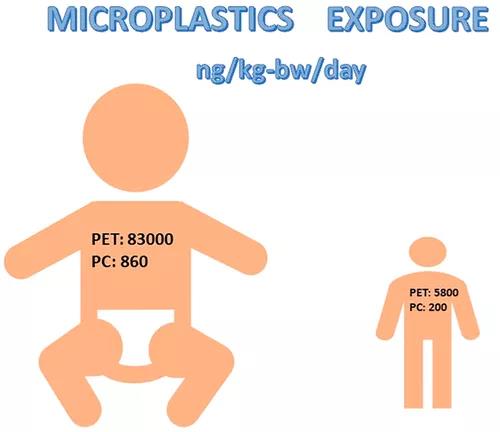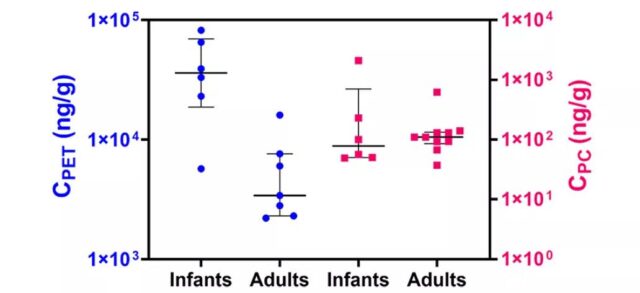Why microplastics in infant feces is higher than that in adults?
- Normal Liver Cells Found to Promote Cancer Metastasis to the Liver
- Nearly 80% Complete Remission: Breakthrough in ADC Anti-Tumor Treatment
- Vaccination Against Common Diseases May Prevent Dementia!
- New Alzheimer’s Disease (AD) Diagnosis and Staging Criteria
- Breakthrough in Alzheimer’s Disease: New Nasal Spray Halts Cognitive Decline by Targeting Toxic Protein
- Can the Tap Water at the Paris Olympics be Drunk Directly?
Why microplastics in infant feces is higher than that in adults?
- Should China be held legally responsible for the US’s $18 trillion COVID losses?
- CT Radiation Exposure Linked to Blood Cancer in Children and Adolescents
- FDA has mandated a top-level black box warning for all marketed CAR-T therapies
- Can people with high blood pressure eat peanuts?
- What is the difference between dopamine and dobutamine?
- How long can the patient live after heart stent surgery?
Why microplastics in infant feces is higher than that in adults?
Baby has become the biggest victim? The latest study: the concentration of microplastics in infant feces is higher than that in adults.
Nowadays, microplastic pollution has become the focus of global attention on the environment and health. More and more studies have found that microplastic particles with a particle size of less than 5 mm can be described as ubiquitous in people’s daily lives: from the depths of the ocean to Everest At the peak, from tap water from home taps to fish and other seafood foods, these non-degradable microplastics have quietly entered the ecosystem from the environment and entered the human body through the layers of the food chain.
At the American Chemical Society‘s Fall 2020 online conference, a study analyzed 47 human tissue samples by mass spectrometry and found that these samples contained microplastics or nanoplastics. Although the harm of microplastics to human health is still unclear, it is worrying that there is constant evidence that this “invisible pollution” hand has reached the baby.
In December 2020, researchers from Italy discovered microplastics in human placenta for the first time. They found microplastics in maternal, fetal and amniotic membranes, and found that the substances carried by these microplastics could interfere with the human endocrine system. , And may cause long-term effects on human health. But so far, the exposure of microplastics in infants and adults has not been quantitatively analyzed.
Recently, the team of Professor Lei Wang from the Key Laboratory of Environmental Processes and Benchmarks of the Ministry of Education of the School of Environmental Science and Engineering of Nankai University and Professor Kurunthachalam Kannan of the Department of Pediatrics and Environmental Medicine of New York University School of Medicine and others found in a small pilot study that PET microplastics The content in infant feces is higher than that in adults.

Related research is titled: Occurrence of Polyethylene Terephthalate and Polycarbonate Microplastics in Infant and Adult Feces, published in the journal ACS Environmental Science & Technology Letters.
This study was the first to quantitatively determine the two types of PET and PC microplastics in adult and infant feces in the United States, and found that the concentration of PET microplastics in infant feces was significantly higher than that in adult feces.
Microplastics that enter humans
Microplastics refer to plastic fragments and particles with a diameter of less than 5mm. According to the source, they can be divided into primary microplastics and secondary microplastics. The former is a variety of man-made industrial plastic products, such as particles in toothpaste, hair spray, cleansing milk and air fresheners. These microplastics can enter the surrounding environment through the discharge of domestic sewage; the latter consists of various plastic wastes through physical, chemical and Broken by biological effects.
Studies have continuously confirmed that microplastics not only exist in the ocean, mountains and other environments, but also enter the human intestines and stomach with food. In 2018, at the European Society of Gastroenterology, researchers reported that as many as 9 microplastics were detected in human feces for the first time, and their diameters were between 50 and 500 microns. Among them, the most common particles are polypropylene (PP) and polyethylene terephthalate (PET), which are the main components of plastic bottles and bottle caps.
For a long time, people believed that plastics are inert. After ingested in the body, they pass through the gastrointestinal tract and are excreted through bile. However, recent studies have shown that microplastic particles smaller than 10 microns in size can pass through cell membranes and enter the human circulatory system.

Source: ACS
Although it is known that humans will be exposed to microplastics, existing studies do not yet understand the extent of exposure. The presence of microplastics in the human placenta further emphasizes the potential intergenerational effects of these non-degradable chemicals on the human body, and they may affect the developing fetus.
The concentration of microplastics in infant feces is significantly higher than that in adults
The study is part of the New York University (NYU) Child Health and Environmental Study (CHES) in 2019. Researchers collected feces from 6 one-year-old babies, meconium samples from 3 newborns and 10 30 —55-year-old adult feces, and using depolymerization and liquid chromatography tandem mass spectrometry (LC-MS/MS), quantitative determination of polyethylene terephthalate (PET) and polycarbonate (PC) in the sample ) Concentration of microplastics.
Ethylene phthalate (PET) and polycarbonate (PC) microplastics are mainly used in the production of textile fibers, water bottles and mobile phone cases. Researchers hope to measure the content of PET and PC microplastics in infant and adult feces. Evaluate the human body’s exposure dose to these two types of microplastics.
The researchers detected PET and PC microplastics in the feces of 6 infants, with concentrations ranging from 5700 to 82,000 ng/g; in 10 adult fecal samples, 8 samples contained PET microplastics with a concentration of 2200 to 16,000 ng/g. Plastic, PC microplastics with a content ranging from 37 to 620 ng/g were detected in all experimental stool samples.
 Figure | The concentration (dry weight) of polyethylene terephthalate (PET) and polycarbonate (PC) microplastics in the stools of 6 babies and 10 adults. (Source: ACS)
Figure | The concentration (dry weight) of polyethylene terephthalate (PET) and polycarbonate (PC) microplastics in the stools of 6 babies and 10 adults. (Source: ACS)
Studies have found that there is a significant difference in the concentration of PET microplastics in infant and adult feces: the concentration of PET microplastics in infant feces is significantly higher than that in adult feces, while the concentration of PC microplastics is not significantly different between the two age groups.
Researchers attribute the source of microplastics ingested by adults and infants to diet, and the high concentration of microplastics in the feces of one-year-old infants can be attributed to the extensive use of plastic products, such as baby bottles, straw cups, tableware, and plastic teethers And toys.
In October 2020, a study published in the journal Nature Food showed that during the process of formulating milk powder, baby bottles will release a large amount of microplastic particles, which are sterilized and exposed to water at 70°C , The amount of microplastic particles released from baby bottles reaches 16.2 million per liter.
In addition, textiles and floor stalls are also a major source of PET microplastics. Infants who often chew and suck on fabrics and crawl on carpets may also ingest microplastics.
The average daily exposure of infants to microplastics is significantly higher than that of adults
The few existing studies show that humans have a wide range of exposures to microplastics, but there are gaps in quantitative research on exposure.
Researchers believe that because most plastic products used by infants are made of polypropylene (PP), the concentration of PP microplastics in infant feces may be greater than that of PET and PC microplastics. The estimated intake of microplastics based on the concentration of microplastics measured in feces mainly comes from dietary sources, and the intake varies from person to person.
 Table | Comparison of daily intake of polyethylene terephthalate (PET) and polycarbonate (PC) microplastics calculated from feces and indoor dust (Source: ACS)
Table | Comparison of daily intake of polyethylene terephthalate (PET) and polycarbonate (PC) microplastics calculated from feces and indoor dust (Source: ACS)
According to the analysis results of the study, the average daily exposure doses of one-year-old infants to PET and PC microplastics through dietary sources are estimated to be 83,000 and 860 ng/kg body weight/day, respectively, and the exposure doses to adults are 5800 and 200 ng, respectively /Kg body weight/day.
The study pointed out that due to the limited sample size, it is impossible to further infer the comprehensive factors that may affect the exposure of microplastics, and the experimental samples may also be contaminated by the collection environment, which may also have an impact on the research results.
Although biomonitoring research can provide a comprehensive assessment of microplastics exposure, such research is still in its infancy. The researchers pointed out that the results of the study provide baseline evidence for the exposure of infants and adults to microplastics, and that these findings can be confirmed and expanded with a larger sample size in the future.
Paper link:
https://pubs.acs.org/doi/abs/10.1021/acs.estlett.1c00559
Why microplastics in infant feces is higher than that in adults?
(source:internet, reference only)
Disclaimer of medicaltrend.org
Important Note: The information provided is for informational purposes only and should not be considered as medical advice.



